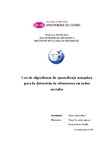Mostrar o rexistro simple do ítem
Uso de algoritmos de aprendizaje máquina para la detección de ciberacoso en redes sociales
| dc.contributor.advisor | Fernández Iglesias, Diego | |
| dc.contributor.advisor | Martín-Rodilla, Patricia | |
| dc.contributor.author | García Barro, Mauro | |
| dc.contributor.other | Universidade da Coruña. Facultade de Informática | es_ES |
| dc.date.accessioned | 2023-07-24T15:37:12Z | |
| dc.date.available | 2023-07-24T15:37:12Z | |
| dc.date.issued | 2023 | |
| dc.identifier.uri | http://hdl.handle.net/2183/33398 | |
| dc.description.abstract | [Resumen]: La evolución que ha presentado la tecnología en los últimos años ha permitido interacciones entre personas que se pensaban inviables, en especial la gran cantidad de comunidades que se alojan en las redes sociales. No obstante, con ello se han trasladado muchas conductas tanto positivas como negativas, siendo una de estas últimas el ciberacoso, el cual ha aumentado de manera exponencial con el paso del tiempo, sobre todo en momentos de pandemia. Es por eso que precisamos anticipar y/o moderar estos comportamientos en la medida de lo posible. Asimismo, debido al crecimiento de este tipo de casos, han surgido una gran cantidad de trabajos que intentan investigar, detectar o mitigar este problema mediante modelos de aprendizaje máquina. Así pues, hemos aplicado diferentes algoritmos de Machine Learning a un dataset con información diversa acerca de diferentes comentarios en posts de Vine, tratando principalmente el aprendizaje supervisado e iterando sobre las distintas fases exploratorias de los datos mediante la metodología CRISP-DM. Tras analizar y procesar dichos datos, se han contrastado los resultados de aplicar esos algoritmos, evaluando su rendimiento y deduciendo cuáles funcionan mejor bajo las condiciones dadas. | es_ES |
| dc.description.abstract | [Abstract]: The evolution of technology in recent years allowed many interactions among people that seemed impossible, specially the great amount of communities inside social networks. Nevertheless, it has been accompanied with several positive as well as negative behaviours, cyberbullying being on the latter. Therefore, we need to anticipate and/or moderate this kind of behaviours as far as possible. Likewise, due to the growth of this type of cases, a large number of works have emerged that try to investigate, detect or mitigate this problem through machine learning models. With that in mind, we have applied different Machine Learning algorithms to a dataset with diverse information about different commentaries in posts of Vine, treating principally supervised learning and iterating between the distinct phases of data exploration with the methodology of CRISP-DM. After analyzing and processing said data, we have compared the outputs of applying those algorithms, evaluating their performance and figuring out which ones work better with given conditions. | es_ES |
| dc.language.iso | spa | es_ES |
| dc.rights | Atribución-NoComercial-CompartirIgual 3.0 España | es_ES |
| dc.rights.uri | http://creativecommons.org/licenses/by-nc-sa/3.0/es/ | * |
| dc.subject | Clasificación | es_ES |
| dc.subject | Ciberacoso | es_ES |
| dc.subject | Aprendizaje supervisado | es_ES |
| dc.subject | Machine learning | es_ES |
| dc.subject | Grid search | es_ES |
| dc.subject | Random forest | es_ES |
| dc.subject | Ciberbullying | es_ES |
| dc.subject | Supervised learning | es_ES |
| dc.subject | Classification | es_ES |
| dc.title | Uso de algoritmos de aprendizaje máquina para la detección de ciberacoso en redes sociales | es_ES |
| dc.type | info:eu-repo/semantics/bachelorThesis | es_ES |
| dc.rights.access | info:eu-repo/semantics/openAccess | es_ES |
| dc.description.traballos | Traballo fin de grao (UDC.FIC). Enxeñaría Informática. Curso 2022/2023 | es_ES |






